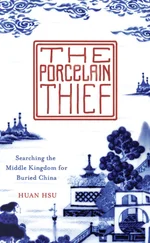Edward Dillon - Porcelain
Здесь есть возможность читать онлайн «Edward Dillon - Porcelain» — ознакомительный отрывок электронной книги совершенно бесплатно, а после прочтения отрывка купить полную версию. В некоторых случаях можно слушать аудио, скачать через торрент в формате fb2 и присутствует краткое содержание. Жанр: foreign_prose, foreign_antique, на английском языке. Описание произведения, (предисловие) а так же отзывы посетителей доступны на портале библиотеки ЛибКат.
- Название:Porcelain
- Автор:
- Жанр:
- Год:неизвестен
- ISBN:нет данных
- Рейтинг книги:4 / 5. Голосов: 1
-
Избранное:Добавить в избранное
- Отзывы:
-
Ваша оценка:
- 80
- 1
- 2
- 3
- 4
- 5
Porcelain: краткое содержание, описание и аннотация
Предлагаем к чтению аннотацию, описание, краткое содержание или предисловие (зависит от того, что написал сам автор книги «Porcelain»). Если вы не нашли необходимую информацию о книге — напишите в комментариях, мы постараемся отыскать её.
Porcelain — читать онлайн ознакомительный отрывок
Ниже представлен текст книги, разбитый по страницам. Система сохранения места последней прочитанной страницы, позволяет с удобством читать онлайн бесплатно книгу «Porcelain», без необходимости каждый раз заново искать на чём Вы остановились. Поставьте закладку, и сможете в любой момент перейти на страницу, на которой закончили чтение.
Интервал:
Закладка:
This question of the composition of the paste has been the subject of many experiments lately at Sèvres. A somewhat animated discussion has raged around it. M. Vogt, who is the director of the technical department in the National Porcelain Works, is well qualified to speak on the subject. We shall not hesitate then to avail ourselves of the conclusions which he arrives at, the more so as they put tersely some important points of which we shall see the importance later on. I refer especially to the relations of the glazes and the coloured decorations to the subjacent paste.
These are, then, the results that M. Vogt arrives at:—
The two extreme types of porcelain, one with 65 per cent. of kaolin and the other with only 35 per cent., when taken from the kiln do not differ in appearance, though one has been subject to a temperature of 1500° C. to ensure vitrification and the other to only 1350° C. Their physical properties, however, are very different. The first, rich in alumina derived from the excess of kaolin, stands without injury variations of temperature, it suits well with a glaze made from felspar, a glaze hard enough to resist the point of a knife. These are excellent qualities for domestic use, but such porcelain does not lend itself well to artistic decoration. At the high temperature required in this case in the firing, the colours of the paste and of the glazes assume dull and tame hues, so as to offer little resource to the artist. In a word, in that part of the decoration that has to be subjected to the full heat of the kiln, the artist has command only of a restricted and relatively dull palette. Again, in the decoration of the muffle-stove the vitrifiable enamels do not become incorporated with the glaze on which they rest. If a decoration in opaque or translucent enamels is attempted, these enamels are apt to split off, carrying with them a part of the glaze. To sum up: the porcelain of which the hard paste of Sèvres, introduced by Brogniart, may be regarded as a type, though excellent for domestic use, is incapable of receiving a brilliant decoration.
Porcelain of the second type, more silicious and less aluminous, is fired at a lower temperature. In order to get a glaze sufficiently fusible to melt at such a temperature to a fine uniform surface, it is necessary to introduce a certain amount of lime into its composition; by this the glaze is rendered at the same time a little softer. But now the lower temperature of the fire will allow of a greater variety and greater brilliancy in the colours either combined with or used under the glaze. When we come to the muffle-fire we can employ enamels of the widest range of colour, yielding a brilliant decoration. On the other hand, this type of porcelain offers less resistance than the other to the action of hard bodies and to rapid changes of temperature—enough resistance, however, so M. Vogt thinks, for all ordinary usages. It is to this type that the porcelain of China, and Japan, as well as the ‘new porcelain’ of Sèvres belongs. The latter comes nearer to the porcelain of the East than any other European ware. Finally, M. Vogt points out that most of the other European porcelains, those made in the Limoges district, in Germany and in Denmark, are of an intermediate type, and that they allow the use of either a felspathic or of a calcareous glaze (Vogt, La Porcelaine , pp. 144 seq. ). 9 9 I should, however, be inclined to class not only much of the porcelain of Japan, but some of that made in Germany and in south-west France, rather in the ‘severe’ kaolinic than in the intermediary class of M. Vogt.
To return to our raw materials, which we may now suppose to be weighed out in a dry state in the required proportions. These are once more thoroughly mixed with water to form the slip or barbotine , which is again passed through a fine sieve. To remove any particles of iron which may have come from the machinery or elsewhere, and which if allowed to remain would form unsightly stains on the finished ware, it is usual to pass the slip at this stage through a vessel in which a number of horse-shoe magnets are suspended. In some of the large French factories a more complicated machine is used for this purpose. The superfluous water has now to be removed either by evaporation or by pressure between canvas bags in the manner described above. The paste may then be passed through a pug-mill to render it uniform in consistency.
A curious question arises with regard to the prepared clay. There was formerly a widespread idea, which may contain an element of truth, that instead of handing the clay at once to the potter, it should be kept, under certain conditions, for a long space of time that it may undergo a process of ‘aging’ and fermentation. By the ‘aging,’ the working qualities, especially of a ‘short’ or non-plastic paste (such as that in use at Sèvres in the eighteenth century, in making the pâte tendre ), were doubtless increased, the more so when the clay was at intervals subjected to fresh kneading and watering. With regard to the long periods for which the clay was kept by the Chinese, the most exaggerated statements were formerly made. Mr. William Burton is of opinion that there may be in some cases an evolution of carbonic acid and sulphuretted hydrogen when natural plastic clays are used, for these may contain both vegetable remains and small quantities of iron pyrites. But the change, he thinks, is chiefly a physical one, due to the settling down of the mass. Might there not also, I would suggest, be a change of a more intimate nature, due to the formation of gelatinous silica and perhaps also of fresh alkaline or other silicates, among these minutely comminuted particles of various materials now freshly brought together? We know very little of the conditions that give to natural clays their peculiar unctuous quality and their plasticity.
We come now to what has been called the ‘shaping’ of the clay, using that word as an equivalent to the French façonnage to include all the processes, throwing on the wheel, turning of the lathe, ‘pressing’ and ‘casting,’ by which the desired form is given to the vessel.
The Potter’s Wheel, perhaps the most ancient of all mechanical contrivances, is still largely used in the shaping of porcelain, and that, too, in a simple form which differs little from that employed three or four thousand years ago in Egypt, 10 10 We can, however, distinguish, in the tomb paintings of the Middle Empire, an earlier form without the lower table. This earlier type, moved by hand from the upper table, was that used by the Greeks at least as late as the sixth century B.C., and a similar primitive wheel is still used in India. On later Egyptian monuments of Ptolemaic time, the potter is seen moving the wheel by pressing his foot on a second lower table, as now at Sèvres and elsewhere. Both forms of wheel appear to have been used by the Italian potters of the Renaissance.
and perhaps for nearly as long a period in China. From an æsthetic standpoint, the wheel holds the same relation to the art of the potter as the brush does to that of the painter. It is perhaps a just cause of reproach against that branch of the ceramic art with which we are now concerned, that so comparatively little use is made of the potter’s wheel. Not only in Europe, but for long ages in China also, the use of the wheel, for many classes of vessels, has been replaced by various processes of moulding. With us, but not in the East, a third process, that of ‘casting’ with liquid slip, is largely used. But when made either by casting or moulding, the hand of the potter is not seen in the shape of the finished vessel. By means of the wheel alone do we get the full expression of the peculiar qualities of a plastic material. This was recognised by the Greeks, when the potter who made the vase signed his name by the side of the painter who decorated it. This it is that gives a certain charm to the roughest earthenware which we may look for in vain in the most elaborately decorated specimen of either Chinese or European porcelain.
Интервал:
Закладка:
Похожие книги на «Porcelain»
Представляем Вашему вниманию похожие книги на «Porcelain» списком для выбора. Мы отобрали схожую по названию и смыслу литературу в надежде предоставить читателям больше вариантов отыскать новые, интересные, ещё непрочитанные произведения.
Обсуждение, отзывы о книге «Porcelain» и просто собственные мнения читателей. Оставьте ваши комментарии, напишите, что Вы думаете о произведении, его смысле или главных героях. Укажите что конкретно понравилось, а что нет, и почему Вы так считаете.












